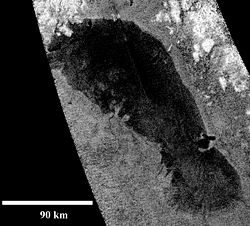Ontario Lacus

RADAR-image of Ontario Lacus taken by Cassini on January 12, 2010.
|
|
| Feature type | Lacus |
|---|---|
| Coordinates | 72°S 183°W / 72°S 183°WCoordinates: 72°S 183°W / 72°S 183°W |
| Diameter | 235 km |
| Eponym | Lake Ontario |
Ontario Lacus is a lake composed of methane, ethane and propane near the south pole of Saturn's moon Titan. Its character as a hydrocarbon lake was confirmed by observations from the Cassini spacecraft, published in the 31 July 2008 edition of Nature. Ontario Lacus has a surface area of about 15,000 square kilometers (5,800 sq mi), about 20% smaller than its terrestrial namesake, Lake Ontario in North America. In April 2012, it was announced that it may be more like a mudflat or salt pan.
On January 12, 2010, Cassini took a more detailed radar-image of Ontario Lacus showing numerous remarkable features. The northern shoreline features low hills, probably about 1 kilometer (3,000 feet) high, and flooded river valleys. A smooth wave-sculpted shoreline, like on the southeast side of Lake Michigan, can be seen at the northeast part of the lake. Smooth lines parallel to the current shoreline could be formed by low waves over time, which were likely driven by winds sweeping in from the west or southwest. The southeast shore features a round-headed bay intruding into the shore.
The middle part of the western shoreline shows the first well-developed river delta observed on Titan, showing that liquid hydrocarbons flowing down from a higher plain have switched channels on their way into the lake, forming at least two lobes. Examples of this kind of channel switching and wave-modified deltas can be found on Earth at the south end of Lake Albert between Uganda and the Democratic Republic of Congo in Africa and in the remains of an ancient lake known as Megachad in the African country Chad.
...
Wikipedia
